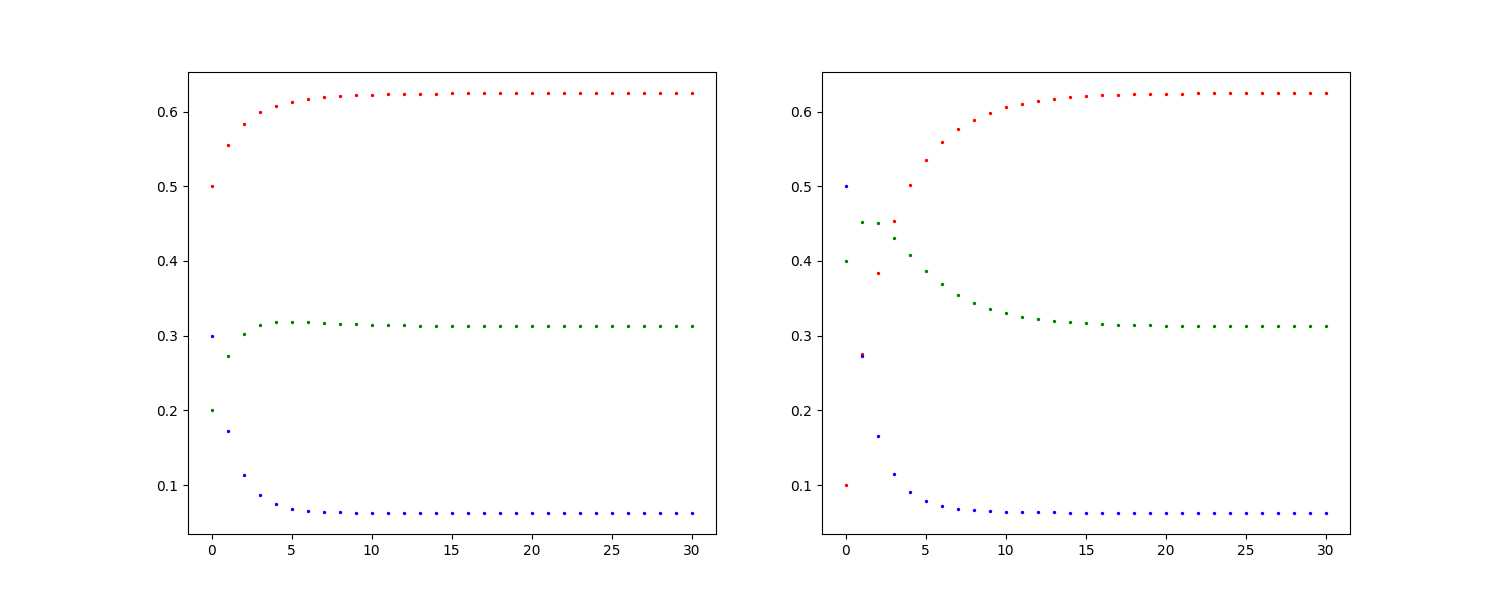一、马尔科夫链和转移矩阵的介绍
created: 2023-06-16T18:01:20 (UTC +08:00)
tags: [马尔科夫链转移矩阵怎么求]
source: https://blog.csdn.net/m0_45161766/article/details/107235866
1、马尔科夫链(Markov chain)概述
机器学习算法中,马尔可夫链在时间序列模型广泛的应用。主要思想是不管初始状态是什么,只要状态转移矩阵不发生变化, 最终状态始终会收敛到一个固定值, 这种无记忆性叫马尔科夫属性。公式为:
$$
\mathrm{P}\left(\mathrm{x}{\mathrm{t}+1} \mid \ldots, \mathrm{x}{\mathrm{t}-2,} \mathrm{x}{\mathrm{t}-1}, \mathrm{x}{\mathrm{t}}\right)=\mathrm{P}\left(\mathrm{x}{\mathrm{t}+1} \mid \mathrm{x}{\mathrm{t}}\right)
$$
2、转移概率矩阵(Transition Probability Matrix)
转移概率矩阵: 矩阵各元素都是用概率表示。其值非负,并且各行元素之和等于1。在一定条件下是互相转移的,故称为转移概率矩阵。 例如:矩阵$A$某一位置$a_{ij})$的值为$P(j|i)$,即从状态$i$转化到状态$j$的概率,如状态转移矩阵为:
$$
A=\left[\begin{array}{ccc}
0.9 & 0.075 & 0.025 \\
0.15 & 0.8 & 0.05 \\
0.25 & 0.25 & 0.5
\end{array}\right]
$$
3、马尔科夫链形成过程
给定初始状态如:$p_0=[0.5, 0.2, 0.3]$, $k$步转化过程为:$p_0=p_0*p_k$。计算机程序需要利用迭代变量,借助循环实现。二步转移概率矩阵正好是一步转移概率矩阵的平方。$k$步转移概率矩阵是一步转移概率矩阵的$k$次方。$k$步转移概率矩阵中,各行元素之和也都为1。 经过多步转化$p_0$收敛于固定值(稳态)。本实例为$[ 0.6248219, 0.31266282, 0.06251528]$。
二、举例说明
1、问题描述
根据上述基本原理,用python程序验证马尔科夫链形成过程:两个初始状态 $p_{01}=[0.5, 0.2, 0.3]$, $p_{02}=[0.1,0.4,0.5]$; 状态转移矩阵都为$A$;
$$
A=\left[\begin{array}{ccc}
0.9 & 0.075 & 0.025 \\
0.15 & 0.8 & 0.05 \\
0.25 & 0.25 & 0.5
\end{array}\right]
$$
经过$k(30)$步完成马尔科夫链转化过程。 要求完成转化过程计算并将其过程与结果用图形表示。
2、代码实现
相比原文进行了代码完善。
import numpy as np
import matplotlib.pyplot as plt
def calanddraw(p0, p, ax, c, n):
"""
Calculate and draw the probability distribution of the Markov chain:
p0 -> p0 * p -> p0 * p * p -> ...
Parameters
----------
p0 : array_like
Initial probability distribution.
p : array_like
Transition matrix.
ax : matplotlib.axes._subplots.AxesSubplot
Axes on which to plot.
c : list
A list of colors for plotting.
n : int
Number of iterations.
Returns
-------
None
"""
# Draw the initial probability distribution
for j in range(len(p0)):
ax.scatter(0, p0[j], c=c[j], s=2)
for i in range(n):
# Calculate the probability distribution of step i
p0 = np.mat(p0) * np.mat(p)
# Draw the probability distribution of step i for each state
for j in range(len(np.array(p0)[0])):
ax.scatter(i+1, p0[0, j], c=c[j], s=2) # 确定画点属性
if __name__ == '__main__':
""" Make up some data for Markov chain analysis """
# Initial probability distribution. The sum of each row is 1.
p01 = np.array([0.5, 0.2, 0.3])
p02 = np.array([0.1, 0.4, 0.5])
# Transition matrix. The sum of each row is 1.
A = np.array([[0.9, 0.075, 0.025],
[0.15, 0.8, 0.05],
[0.25, 0.25, 0.5]
])
""" Calculate and draw the probability distribution of the Markov chain """
n = 30 # Iteration times
c = np.array(['r', 'g', 'b']) # Color of each state
fig = plt.figure(figsize=(15, 6))
ax1 = fig.add_subplot(121)
ax2 = fig.add_subplot(122)
calanddraw(p01, A, ax1, c, n)
calanddraw(p02, A, ax2, c, n)
plt.show()
3、运行结果
如下图所示,两个初始状态的不同的三个初始值(初始状态),经过相同的状态转移矩阵完成马尔科夫链转化后,不仅数值本身收敛,而且两组收敛值趋于相同:






Comments NOTHING